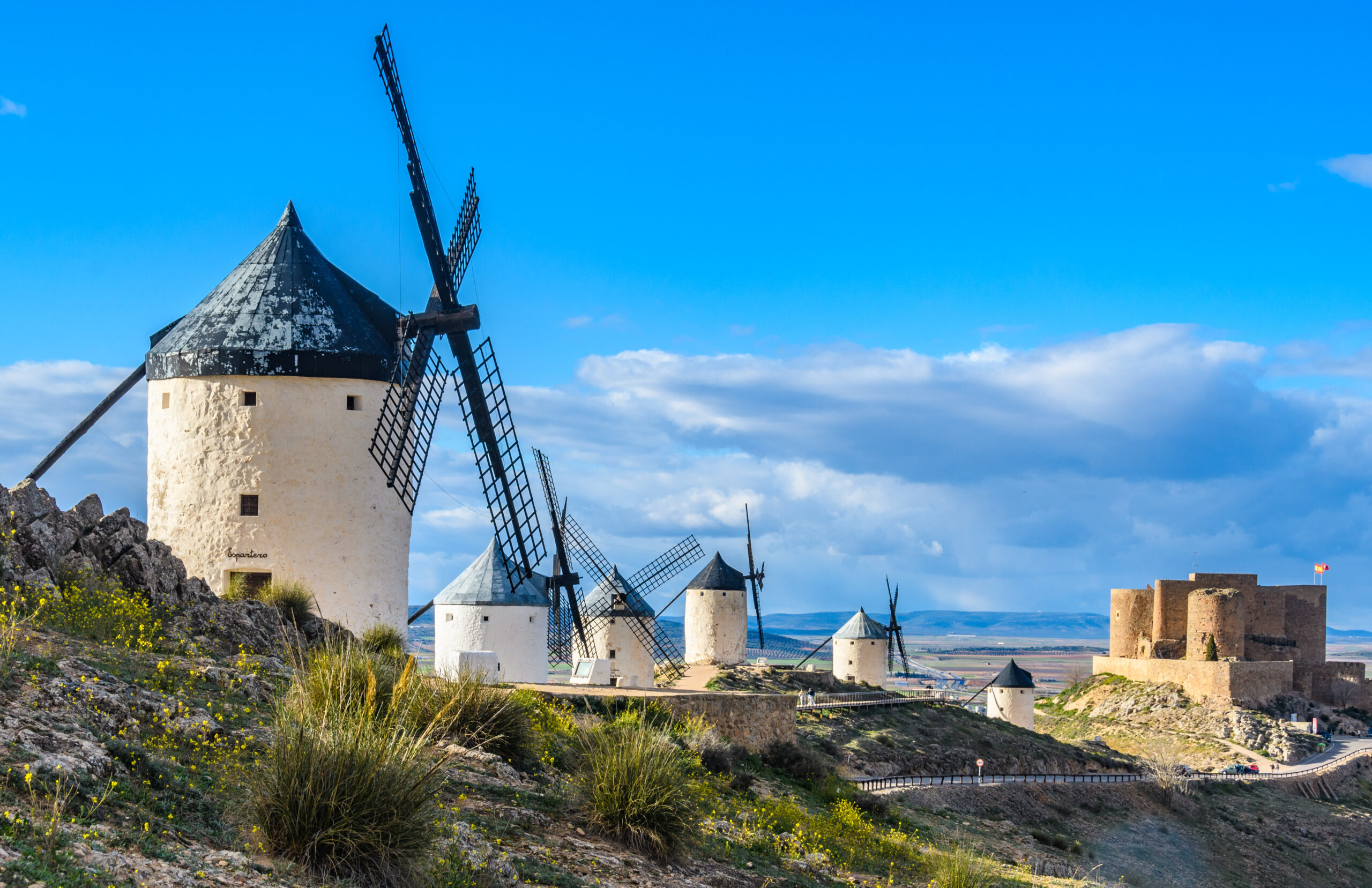Have you ever heard of the autonomous community of Castilla-La Mancha in Spain? Small, pretty mountain villages, white windmills and untouched natural parks are just as much a part of the landscape here as historic buildings. For example in Toledo, the capital of Castilla-La Mancha and one of the most visited places in the region.
Come with us on a journey through the home of the novel hero Don Quixote, which is also known as the largest wine-growing region in Europe.
If you approach this community of around 79,400 km² in the heart of Spain, more precisely in the center of the Iberian Peninsula, it is above all the exceptionally beautiful landscapes that immediately catch your eye. Pretty little farming villages alternate with white windmills, beautiful nature parks such as the Parque Natural de las Lagunas de Ruidera, the Parque Natural de La Serrania de Cuenca or the Las Tablas de Daimiel National Park invite nature lovers on an exciting expedition.
The highest elevation in La Mancha, the Montes de Toledo with the Las Villuercas and Rocigalgo mountains, also characterize the region, while the Rajo, Guadiana and Júcar rivers that run through it lend it an idyllic landscape. Add to this the magnificent vineyards, wheat fields and olive groves and you have a great place for nature lovers!
Cuenca
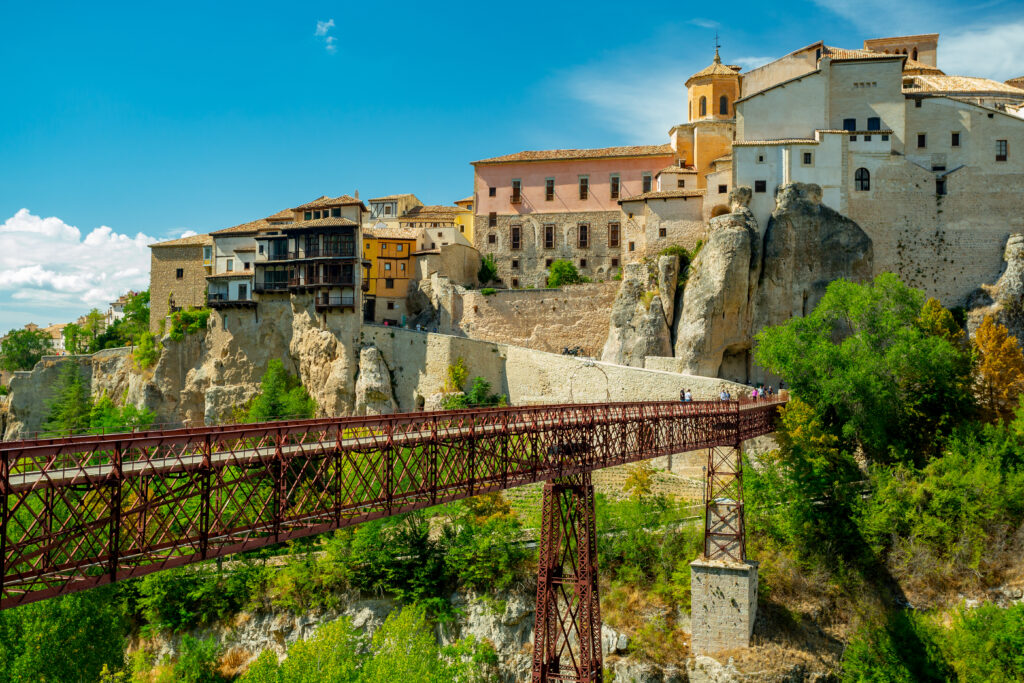
Cuenca, the capital of the province of the same name, lies at an altitude of 946 m and has around 56,000 inhabitants. While the new town (Ciudad Nueva) with all its central facilities lies on the plain, the historic old town (Ciudad Vieja) can be reached by climbing steep steps. This is a UNESCO World Heritage Site.
The main street is Calle Alfonso VIII, named after the King of Castile, who conquered the city after a month-long siege in 1177. This ended the rule of the Moors.
The Plaza Mayor forms the center of the old town. Here stands the Gothic cathedral of Cuenca, which has lost some of its former appearance over the course of time. For example, a tower collapsed in 1902, causing considerable damage to the façade. The high altar inside the church is worth seeing.
There is also a small museum in the Palacio Episcopal.
To the south-east of the cathedral are the Casas Colgadas, the so-called hanging houses. Due to the permanent lack of space on the city hill, the houses were built directly on the slope above the valley of the Huécar stream. The old iron bridge Puente de San Pablo offers a beautiful view of the Casas Colgadas.
Beautiful views of the breathtaking location of Cuenca can be enjoyed from the highest point of the old town towards the Barrio del Castillo district. This is where the main street leads from the Plaza Mayor in a northerly direction.
Sigüenza
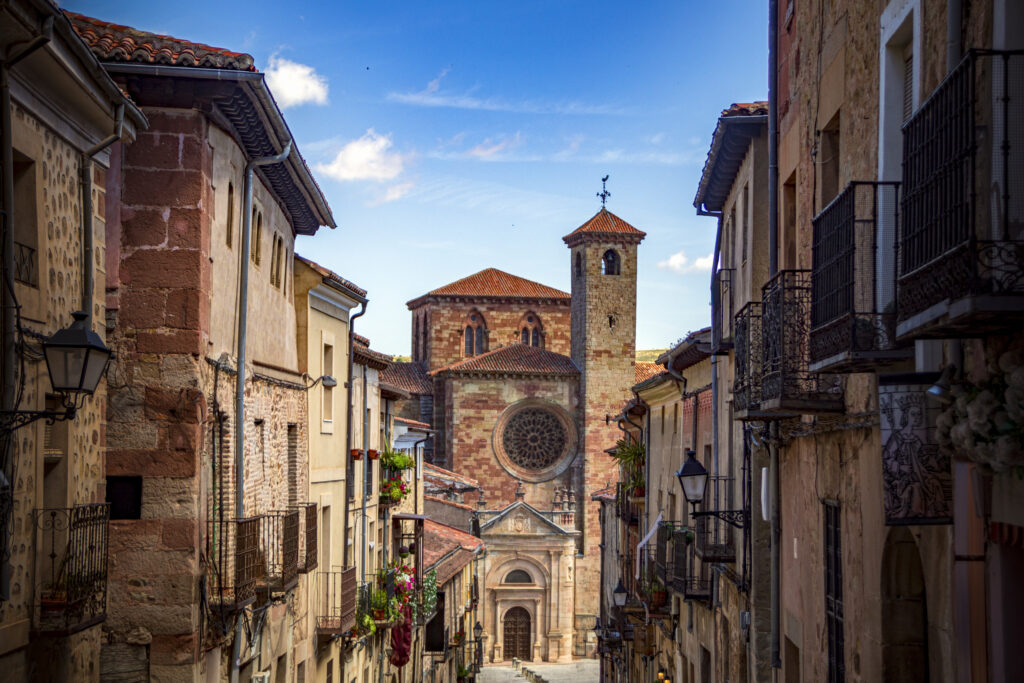
Medieval, Renaissance and Baroque – Sigüenza combines these architectural styles in a relatively small area. The small town on the upper reaches of the River Henares is a popular excursion destination, especially at weekends.
The medieval ensemble between the mighty castle on one side and the cathedral on the other is well worth seeing. Other attractions include an unusual tomb, delicious tapas and other culinary delights for which Sigüenza is famous.
The two square towers of Sigüenza Cathedral give this main church of the Sigüenza-Guadalajara diocese a defensive aspect. Construction of the church began in the 12th century in the style of the master church builders of the Cistercian order. The main attraction is the tomb of a young knight, as it is relatively unique in its design.
In front of the cathedral is one of the most beautiful main squares in Castile, the Plaza Mayor of Sigüenza. The surrounding buildings, in which the clergy and others lived, are supported by arcades. The town hall stands at the front. This square was commissioned by the once powerful Cardinal Mendoza. Market days and bullfights used to take place where tourists bustle today. The balconies offer excellent box seats.
The historic old town of Sigüenza is surrounded by a well-preserved city wall, whose gates still allow access today. From the square in front of the Castillo, a path leads around the castle in an anti-clockwise direction, which is later aptly named the Paseo de la Ronda (circular path).
Monasterio de Uclés
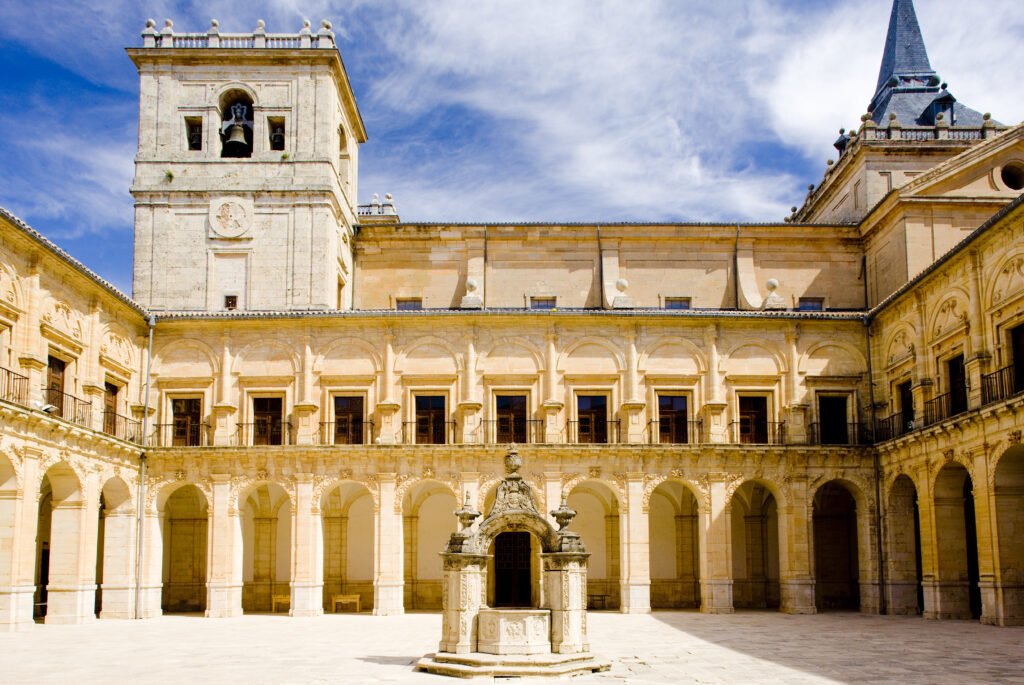
The “Monasterio de Santiago Apóstol”, also known as the “Monasterio de Uclés”, is enthroned on a hill above the small town of Uclés. The monastery complex was built between 1529 and 1735 on behalf of the Order of Santiago on the remains of an old fortress. As a result of the long construction period, the buildings display three different architectural styles: Plateresque, Herrerian and Churrigueresque.
The complex consists of the monastery building with an inner courtyard and a two-storey cloister, a church with a crypt and a sacristy as well as the remains of the old fortress with a parade ground. All parts of the complex are richly decorated, which is why it is also known as the Escorial de La Mancha. The monastery and the remains of the fortress were declared a National Monument (Bien de Interés Cultural) in 1931.
Albacete
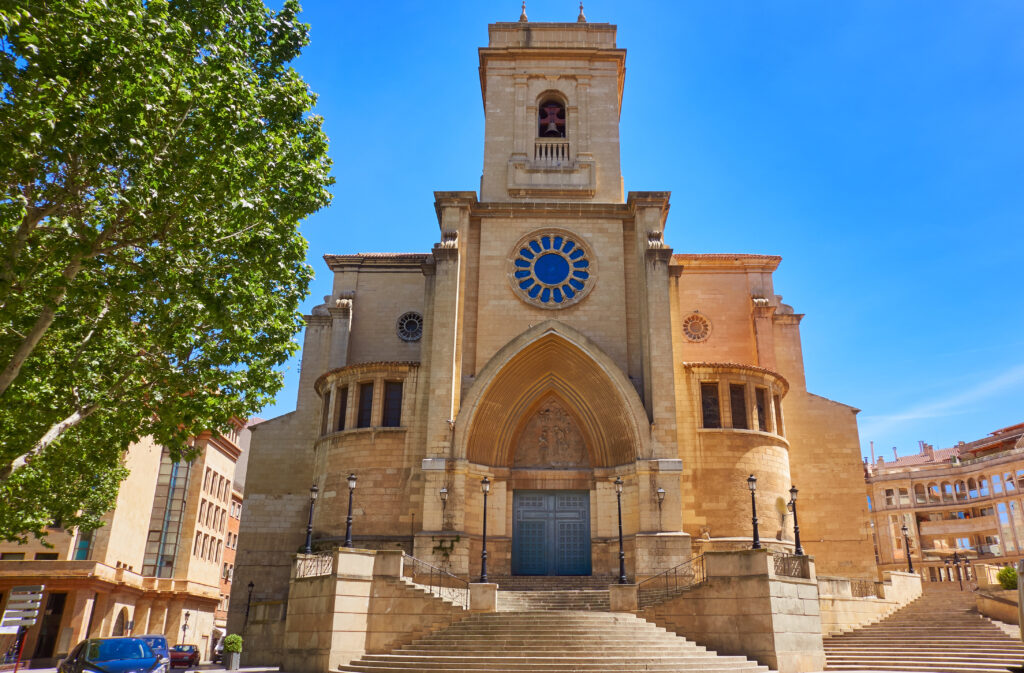
The development of Albacete into a major city in the south-east of the Castilla-La Mancha region only began at the start of the 20th century. Before that, the town, aptly named Al-Basit (the plain) by the Moors, was an insignificant spot in the south of the Spanish plateau. In September, the town is the setting for one of Spain’s biggest popular festivals, the Feria de Albacete.
The central square in the old town is the Plaza del Altozano. Here you will find the old town hall, which now houses the Museo Municipal. On the eastern flank of the square stands the Gran Hotel, the former headquarters of the International Brigades, which fought on the side of the Republic against the fascist putschists during the Spanish Civil War.
The Gran Hotel is one of the relatively numerous modernist-style buildings erected by the up-and-coming and wealthy bourgeoisie in the center of the city at the beginning of the last century.
To the northwest, in the Plaza Virgen de los Llanos, stands the Cathedral of Albacete (16th century), whose main façade is in the neo-Gothic style.
Modernism at its best can also be experienced in the Pasaje de Lodares.
This shopping gallery, which connects the old town streets Calle Mayor and Calle del Tinte, was a symbol of the city’s economic boom when it opened in 1925.
The nearby Calle de Tejares is a popular place to go out at lunchtime and in the evening, known to the locals as La Zona.
Ciudad Real
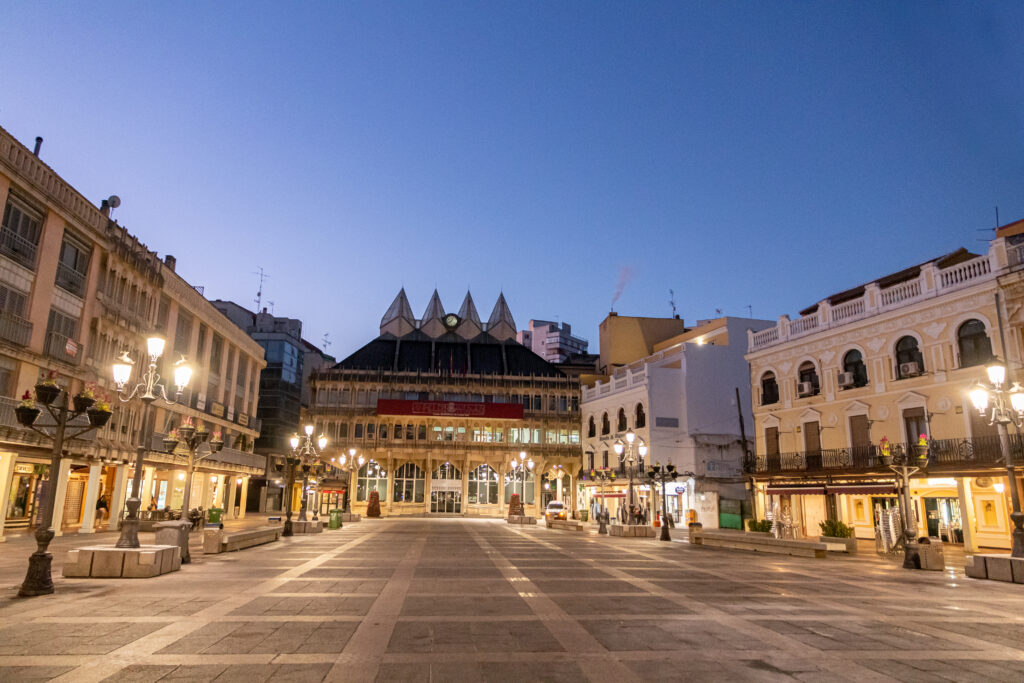
Ciudad Real, a modern city with the characteristic charm of La Mancha, is nestled in the Campo de Calatrava, a hilly landscape rich in history. Accessibility via high-speed train on the Madrid-Sevilla line makes the city an accessible destination for urban explorers. Its cuisine is famous for its use of regional products such as game, cheese and wine, which bring the essence of La Mancha to the plate.
Medieval architectural drawings tell stories of the coexistence of Christians, Moors and Jews, visible in the preserved city walls and 130 fortress towers. Ciudad Real, which became the capital of the province of La Mancha in the 17th century, reflects remarkable economic growth in its architectural buildings.
Mudejar architecture can be seen in the magnificent Puerta de Toledo and other historic churches, which combine Christian and Moorish elements. Nearby, the Cabañeros and Tablas de Daimiel National Parks are home to unique ecosystems and offer a glimpse of Spain’s unspoiled landscapes.
Discover Ciudad Real, the beating heart of Don Quijote’s La Mancha, where the Middle Ages come alive in the impressive city walls and fortress towers, combining modern vibrancy with the authenticity of La Mancha.
Almadén
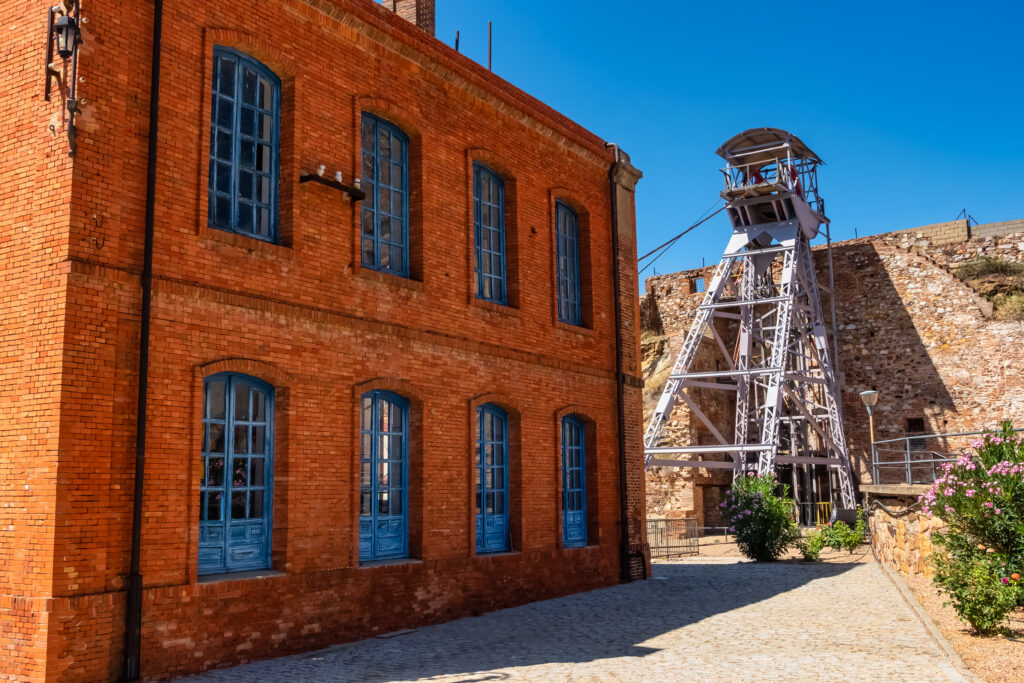
The Almadén mines in Ciudad Real are part of the “Heritage of Mercury: Almadén and Idrija” complex, which has been declared a World Heritage Site by UNESCO. It is one of the largest mercury deposits in the world, which has been mined since Roman times and up to the present day.
It is estimated that more than 250,000 tons of mercury were mined in the Almadén mines. The mine bears witness to the great importance of this metal for the modern economy and the technological innovations that developed thanks to the mining techniques used to extract it.
Today, the Almadén Mining Park offers visitors the opportunity to visit the Mining Interpretation Center (where the mining techniques and the different professions related to mercury extraction are explained), enter a mine (in galleries dating from the 16th to 18th centuries) and get to know the so-called “cercos mineros” (surrounding the mine), the Mercury Museum and the former Royal Mining Hospital.
In Almadén, mercury and its importance are omnipresent in the architecture, customs and traditions.For this reason, the UNESCO designation also includes the old town of Almadén, its hexagonal bullring, the Royal Miners’ Hospital of San Rafael and the Royal Forced Labor Prison for prisoners who served their sentences as workers in the mines of Almadén.
Almagro
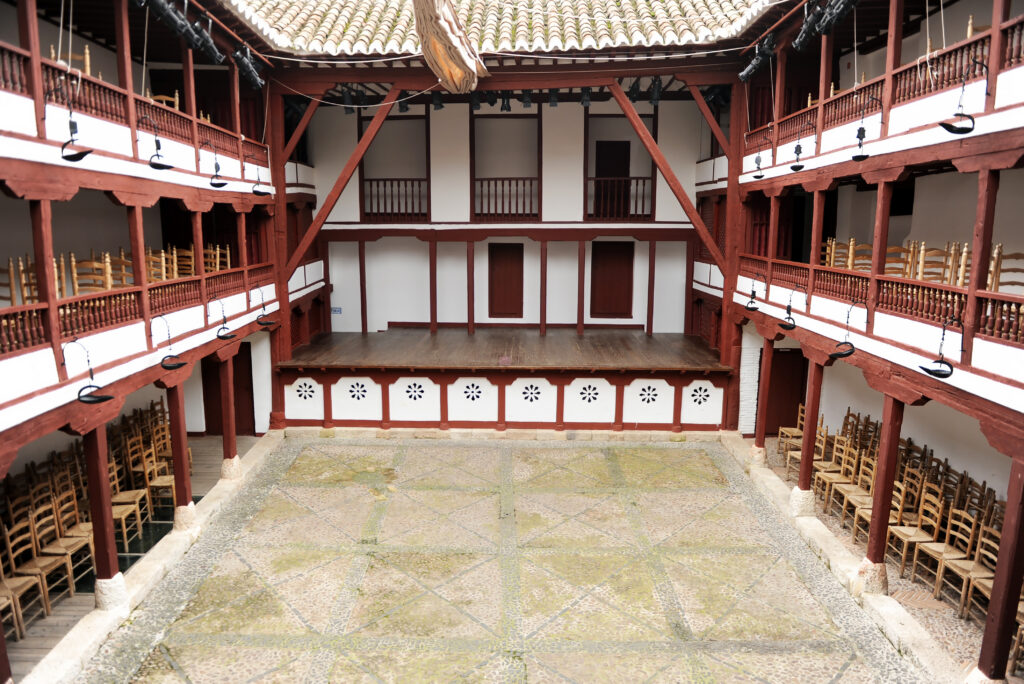
Theater and Almagro, these two terms belong together. On the Plaza Mayor is the “Comedy Theater” (Corral de Comedias) from the 17th century. It is the best-preserved historical theater in Spain.
The small town, which is well worth a visit, is located in the middle of the historic Campo de Calatrava landscape at an altitude of 646 meters in the south-western part of the Castilla-La Mancha region. The town is located on the historic route between the cities of Córdoba and Toledo.
In the center of Almagro is the large, rectangular Plaza Mayor with the town hall. The square was redesigned in the 16th century. At the same time, the Swabian bankers of the Fugger family founded a branch in Almagro. They were among the most important financiers of the chronically cash-strapped Crown of Castile. As security, they received rights to the mercury mine near the town of Almadén. Their place of business was the Palacio de los Fúcares.
The Corral de Comedias is located in a building in the southern row of houses on the Plaza Mayor. The historic theater courtyard was only rediscovered during a renovation in 1950. Today, with its 300 seats, it is one of the most important venues for the annual summer festival of classical theater.
Almagro not only has one of the most beautiful squares in Castilla-La Mancha. Numerous palaces and manor houses, churches and monasteries dominate the townscape.
Alcalá del Júcar
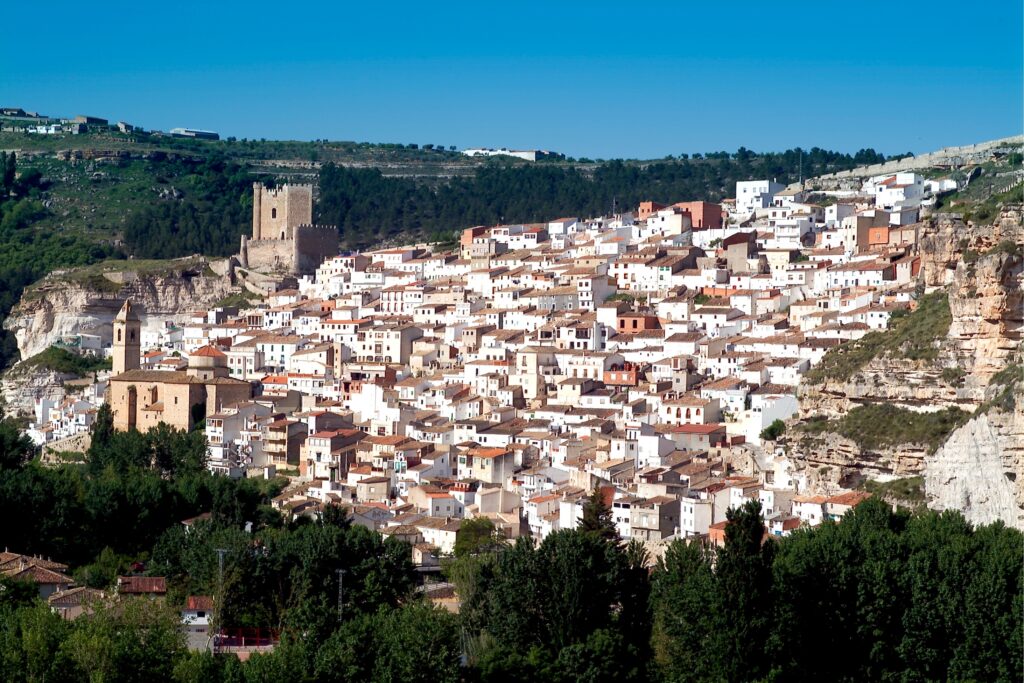
Alcalá del Júcar is a small town that captivates you from afar thanks to its picturesque location. The whitewashed houses cling to a steep slope, with a slender church tower rising defiantly in front of them. The massive tower of a castle towers above it all.
In many places, the Río Júcar carves its way through narrow gorges in the limestone mountains of La Mancha. Over millions and millions of years, it has created breathtaking backdrops for cities such as Cuenca or smaller towns such as Alarcón and, as we see now, Alcalá del Júcar.
Calle Cuesta Hondonera leads up to the old town with the church of San Andrés, which can serve as a landmark. Construction of the current parish church began at the beginning of the 16th century in the late Gothic style. Baroque elements were later added during renovations. The neoclassical tower and façade date from the 19th century.
For the further ascent to the Castillo de Alcalá, the simple “up” must suffice as orientation.
The course of the alleyways is as confusing as we would expect from an originally Moorish town planning.There is not a signpost to the Castillo on every corner. Instead, there are signs inviting you to visit various caves.These are home to small museums, galleries and restaurants.
The fortress on the highest point above the River Júcar, the Castillo de Alcalá del Júcar, was originally built by the Moorish rulers.It was considered impregnable for a long time until Alfonso VIII succeeded in 1213 and incorporated the town into the Kingdom of Castile.
Alcaraz
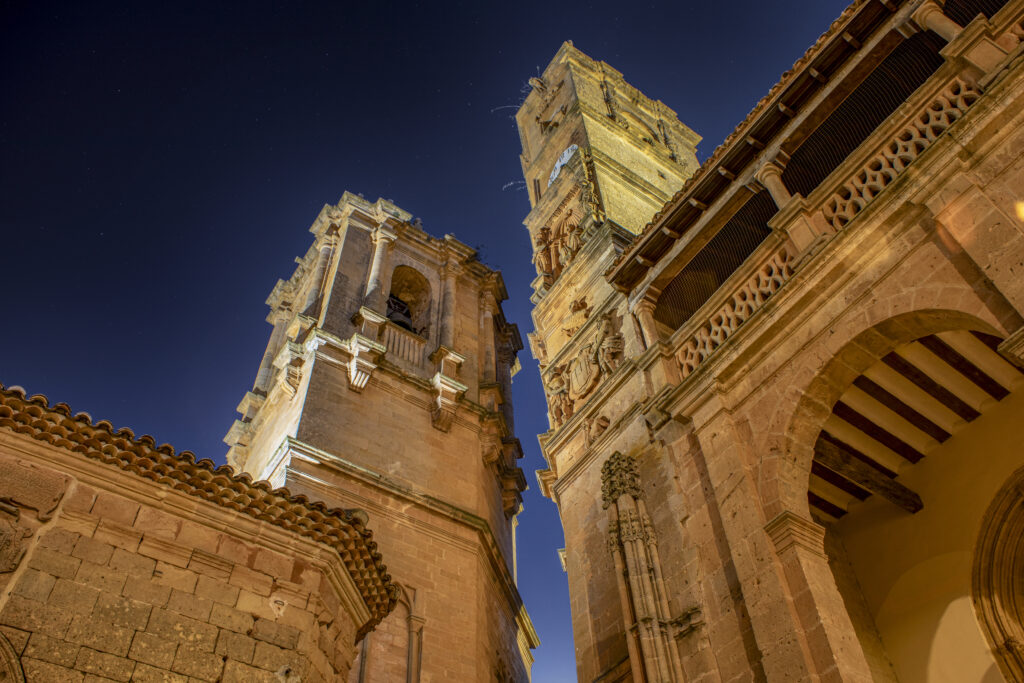
The small town boasts one of the most beautiful main squares in Spain. The town lies in a valley on the northern edge of the Sierra de Alcaraz in the south of the Castilla-La Mancha region. Sights include the old town, characterized by Renaissance architecture, and the castle ruins on the hill with beautiful views of the surrounding area.
The listed historic town center is home to numerous sacred and secular buildings from the Renaissance period. The old town nestles picturesquely against the San Cristóbal hill (1,028 m). The ruins of a fortress have been preserved on the hill.
The most important reason to make a detour here is the exceptionally beautiful main square, around which the historical sights are grouped. The Plaza Mayor (see map) is rightly one of the most beautiful squares in Spain.
On the northern side is the Lonja de Santo Domingo stock exchange. The two towers facing each other, the Torre del Tardó (Torre del Reloj) and the church tower of the Iglesia de la Santísima Trinidad y Santa María, offer a unique picture. To the west and east, the square is bordered by the Lonja de la Regatería and the Lonja del Alhorí. This building now houses the town hall.
It is nice to stroll through the alleyways of the old town. Wrought-iron balconies and beautiful entrances adorn the facades of the houses. Two warriors adorn the entrance to the Casa de los Guerreros on Calle Mayor.
Tembleque
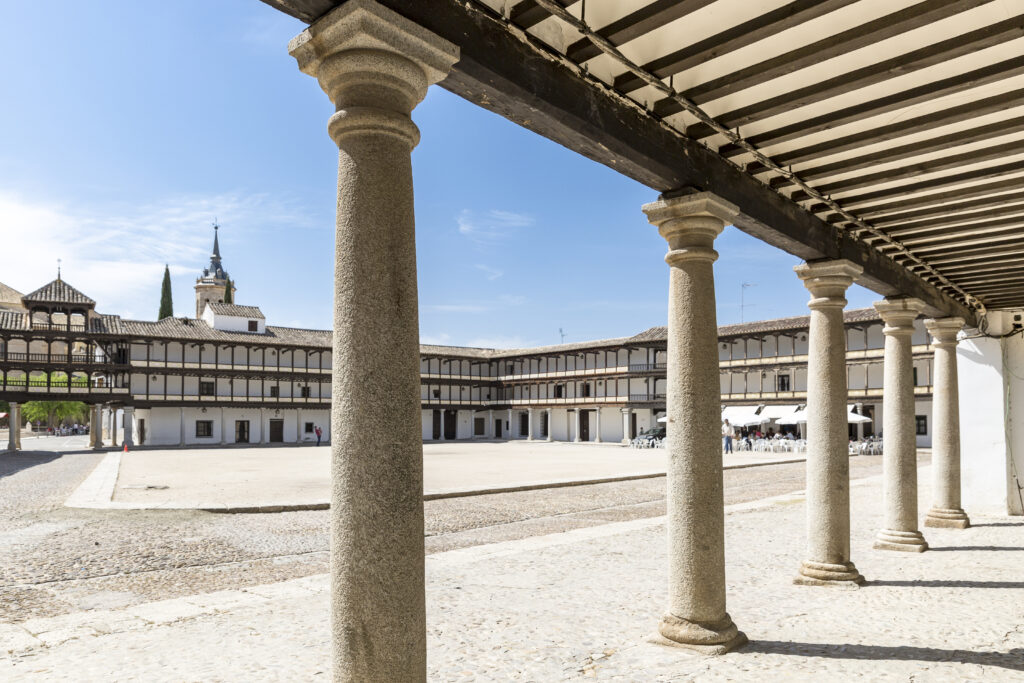
The Plaza Mayor is a beautiful example of Castilian architecture, following the pattern of the old open-air comedy courts. On the north, south and east sides of the square plaza are porticoes with granite columns. Above them are two storeys with corridors supported by wooden pillars.
The facades are whitewashed and the balcony railings are decorated with the cross of St. John. The square was originally designed as a setting for bullfighting events and festivals, which explains the special arrangement of the galleries and the tower for the dignitaries.
Under the arcades there are numerous bars where you can eat or have a snack in peace and quiet. The town hall, housed in a baroque building from the 17th century, is also located on this square.
There are also other sights to visit in Tembleque, such as the Plaza de la Orden, which is connected to the Plaza Mayor via a passageway, the Casa de las Torres, an 18th century Baroque manor house, or the former stagecoach station just outside the town.
Talavera de la Reina
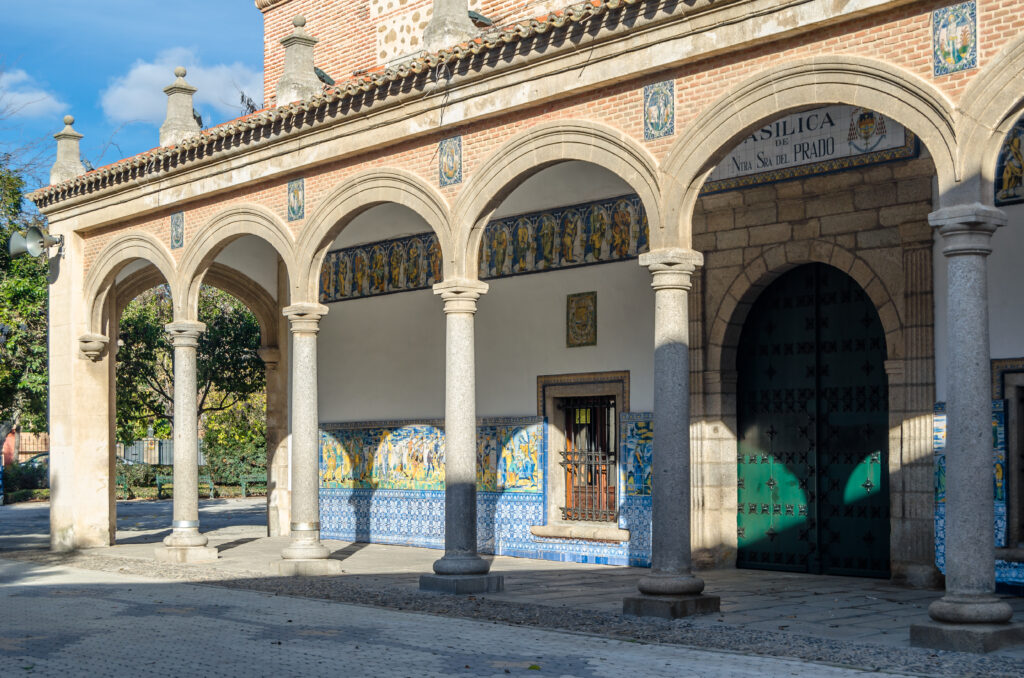
The traditional methods used for five centuries to produce ceramics in these Spanish and two Mexican towns have been declared Intangible Heritage of Humanity by UNESCO. Would you like to come to Spain, watch these wonderful ceramics being made and perhaps take a souvenir home with you?
In Talavera de la Reina there are still artisans who make household utensils, decorative objects or architectural elements from ceramics. The most outstanding thing about their work is that the various processes (production, decoration and glazing) are largely similar to those of the 16th century, which is why it has been awarded the UNESCO distinction. In fact, potters and ceramists still pass on their knowledge orally to new generations.
You will notice that each workshop has its own characteristics, which can be seen in the different details of the modeling, the colors or the glaze of the always unique objects.
If you would like to learn more about this traditional, ever-changing craft, a visit to this town is a must. Here you will be able to admire impressive objects and discover that ceramics is a way of life here.
Consuegra
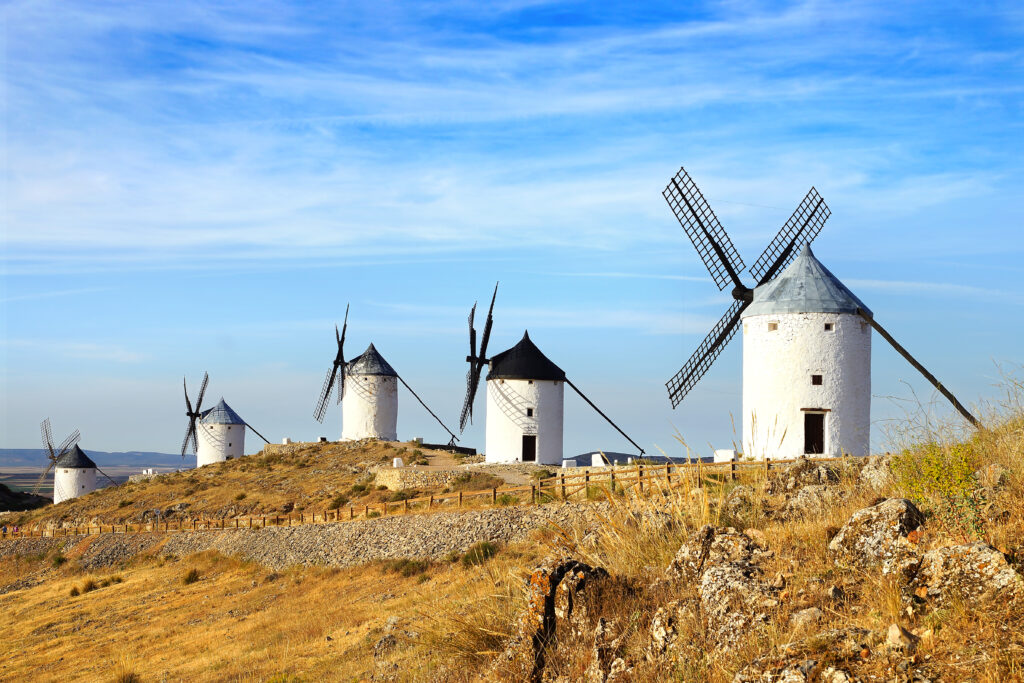
This important town in the province of Toledo in the La Mancha region was once founded by the Romans.
It lies at the foot of the Cerro Calderico and is home to an impressive castle with a towering keep as well as several of the typical regional windmills. Five of the twelve mills still retain their complete mechanism, with the “Sancho” mill, named in honor of one of the main characters in the famous novel Don Quixote de La Mancha, being particularly noteworthy.
The town of Consuegra also has other places of interest for visitors, such as the town hall, the “Corredores” building with the municipal museum, the Casa de la Tercia tower and the churches of San Juan and Santísimo Cristo de Veracruz with the Museum of Offerings. The castle dates back to the beginning of the “Reconquista”.
At the time of Alfonso VIII, the complex with its double ring of walls and several towers was given to a brotherhood that founded the “Gran Priorato de La Mancha” order of knights. Consuegra’s town hall is built in the Renaissance style and is located in the Plaza de España, where you can also see several houses with wooden balconies.
Guadalajara
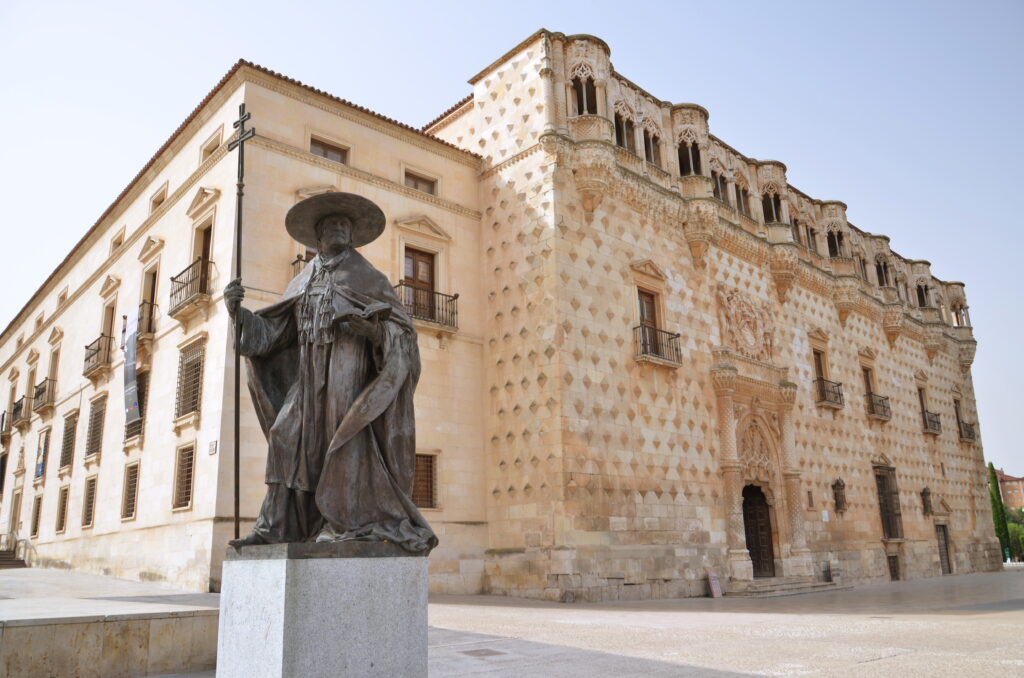
Guadalajara’s great past has left an important architectural legacy in its old town. The Calle Mayor pedestrian street, which runs through the old town, is home to buildings of great historical value, such as the town hall, the mansions of the Plaza de los Dávalos and the old Mendoza Palace, whose inner courtyard is an excellent example of Plateresque art.
However, the most important secular building in Guadalajara is the Infantado Palace, which is also the city’s landmark. Juan Guas was commissioned by the second Duke Íñigo de Mendoza in 1480 to begin construction of this building, which now houses a museum, the provincial archives and the municipal library. The magnificent work in the Isabelline style has a splendid Renaissance façade and is structured around the two galleries of the Lion Courtyard.
Guadalajara preserves many examples of sacred architecture, such as the baroque Jesuit church of San Nicolás el Real, with its remarkable altar and a 15th century alabaster sarcophagus, the church of Santiago (14th century) in the Gothic Mudejar style with beautiful chapels and baroque façade, and the Santa María la Mayor cathedral, which was built on the site of an old Mudejar mosque and rebuilt in the 17th century.
One of the most important nature reserves in Castilla-La Mancha is the Hayedo de Tejera Negra Natural Park, which is located in the north-west of the province of Guadalajara. It is also home to Majaelrayo, a small village on the Black Architecture Route, known for its villages with typical black slate houses.
Chinchilla del Monte Aragón
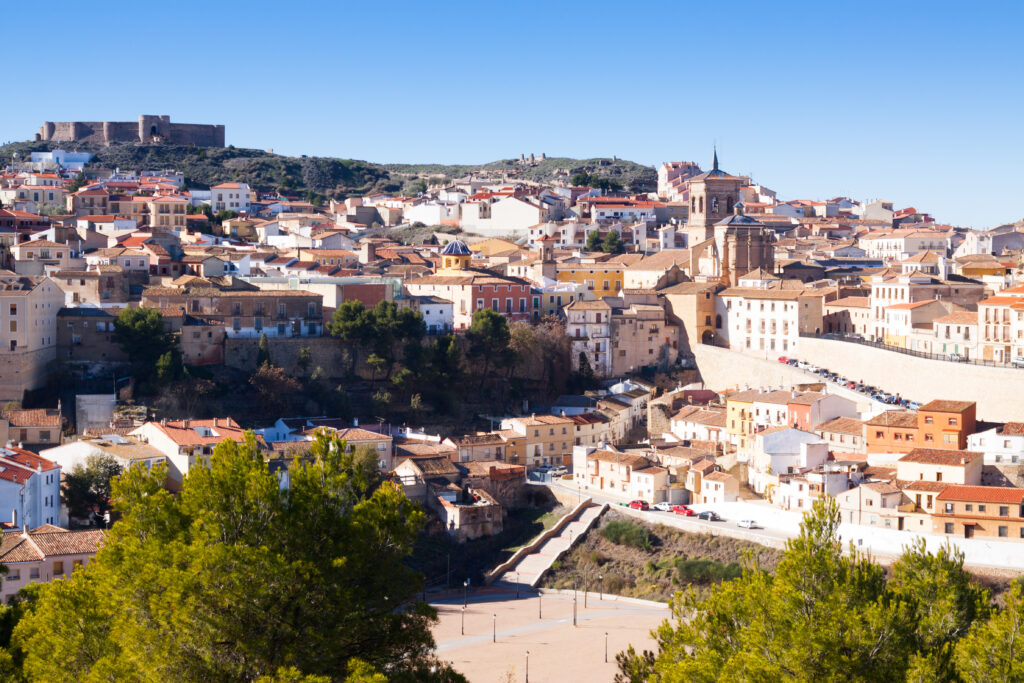
The town of Chinchilla del Monte Aragón is located on a hill that dominates the flatlands of La Mancha. It impresses with its castle, which was built in the 15th century by Juan Pacheco, the Marquis de Villena, as well as its medieval townscape.
The best way to explore Chinchilla de Monte Aragón is on foot. This allows you to admire the manor houses and courtyards at your leisure and discover the Hondón district with its characteristic houses dug into the ground. Remains of the old city wall, some parts of which date back to the Moorish period, and the Puerta de Tiradores gate can still be seen today.
The moat dug out of the rock, which is 10 m wide and 6 m deep, is also impressive. In the town center you can visit Arab baths, houses with family coats of arms from the 16th to 18th centuries, such as the manor houses of the López de Haro and Núñez Robles families, the Barnuevo palace, the Casa de la Tercia from the 16th century and the old public granary.
The town hall, which was built between the 16th and 18th centuries, stands on the Plaza Mayor. The most important religious building in the city is the parish church of Santa María del Salvador, which features a mixture of different artistic styles, from Gothic to Baroque. Also worth seeing are the San Julián Hospital, the Santo Domingo Monastery and the remains of the Santa Ana Monastery.
Almansa
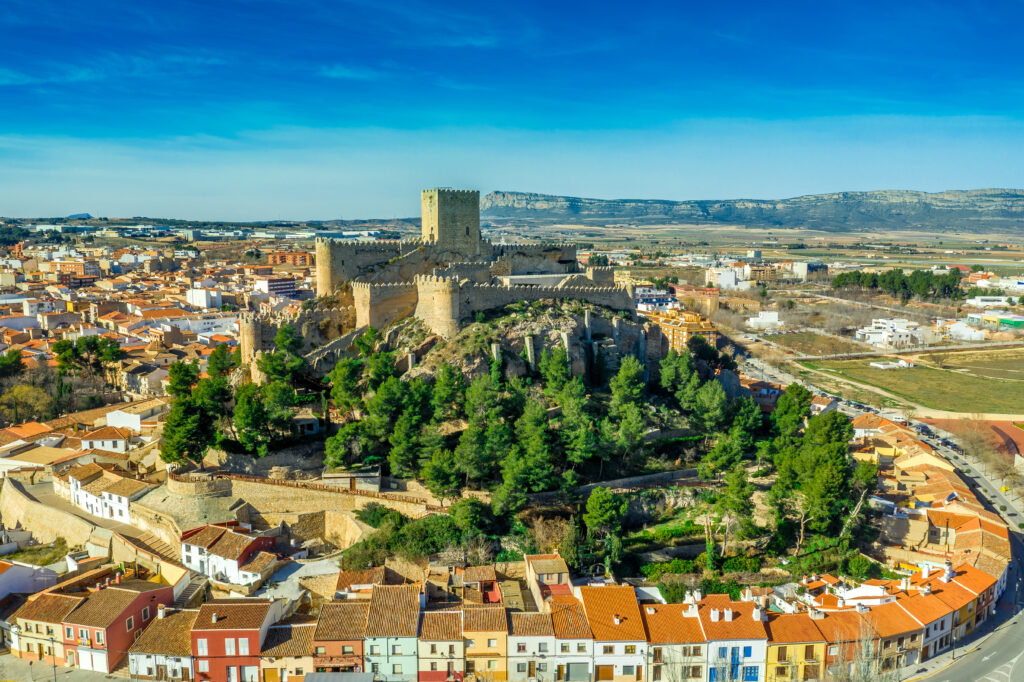
The most important sight in Almansa is an impressive castle that dominates the town on a large rock. It is of Moorish origin, but was rebuilt in the 14th century by Don Juan Manuel.
The historic part of Almansa, which has been declared a Historic-Artistic Site, consists of narrow streets arranged around the castle. The palace of the Counts of Cirat, also known as the Casa Grande, is particularly worth seeing and features a beautiful Mannerist-style portal.
Other fine examples of secular architecture are the 17th century manor houses, such as that of the Enríquez de Navarra family and that of the Marquis of Montortal, the former public granary and current cultural center and the town hall.
Among the religious buildings, the parish church of La Asunción from the 16th to 19th centuries, the Augustinian monastery with its baroque façade, the San Francisco monastery and the San Blas pilgrimage chapel are particularly worth a visit.
Villanueva de los Infantes
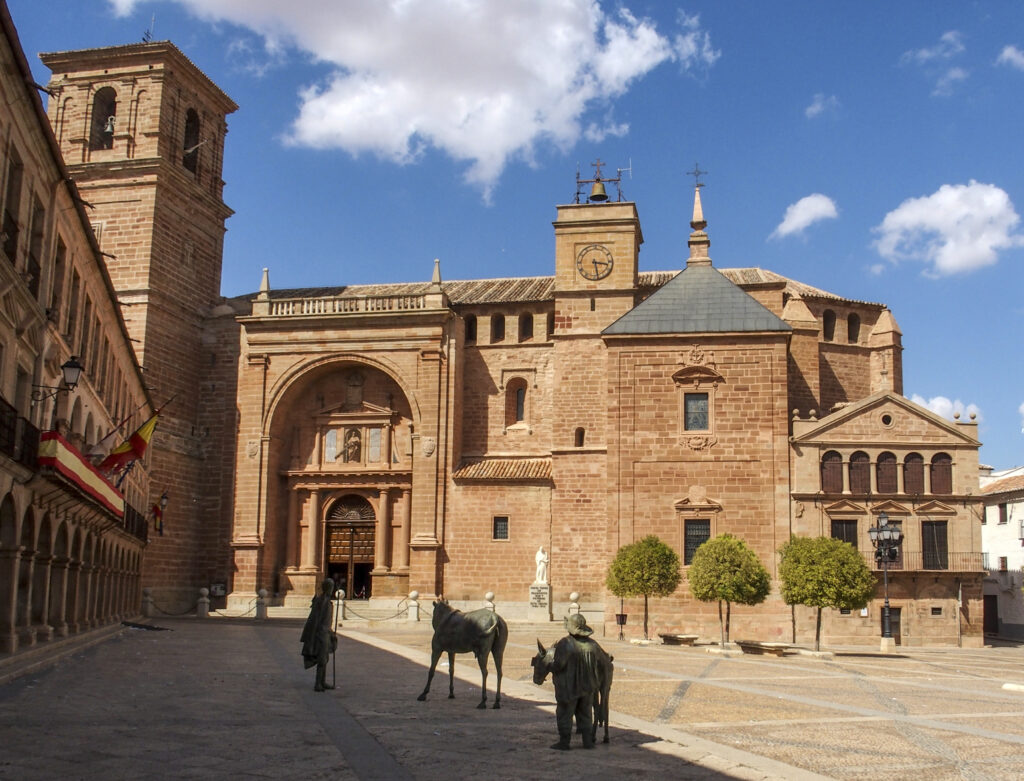
The town has very interesting architecture, the most notable of which are the numerous religious buildings and the manor houses and palaces from the 16th and 17th centuries.
The most representative religious building in Villanueva de los Infantes is undoubtedly the 16th century church of San Andrés, where you can visit interesting chapels such as El Santísimo, Los Bustos with the tomb of Quevedo and that of the Knights of Santiago, as well as the crypt of St. Thomas.
Also worth seeing are the 17th-century Hospital El Remedio, the 16th-century corn market, which also served as a prison, the 17th-century Casa del Arco, the 16th-century Casa de los Estudios or Colegio Menor, the Casa Solar de Santo Tomás de Villanueva, the oratory and the portal of the Casa de la Inquisición.
The convent churches of Santo Domingo, La Encarnación and the Franciscan order are also worth a visit. Among the manor houses and palaces, we recommend the building of the Knights of Santiago, the 17th century house of the Marquis of Melgarejo with paintings by Carreño and Juan de Juanes and the 16th century palace of Los Bustos.
The town is also famous for having been mentioned several times in the famous novel Don Quixote by Miguel de Cervantes, and one study claims that Villanueva is the place referred to in the famous first sentence of the work with “in a town in La Mancha”.
Cabañeros
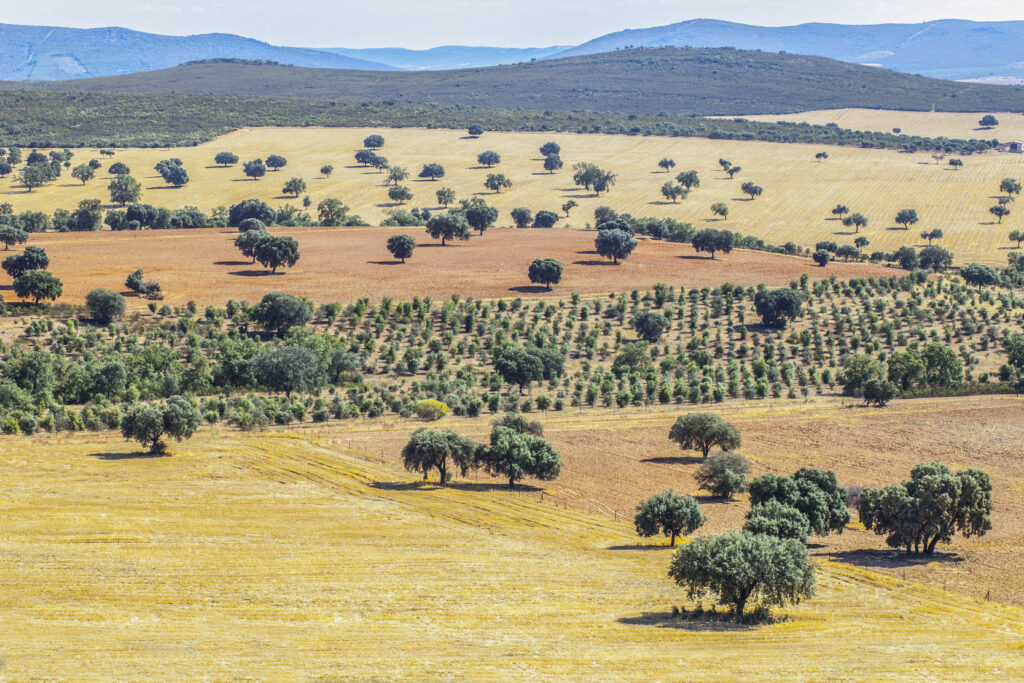
This national park, located in the Montes de Toledo, is closely linked to the history of the city of Toledo, to which it belonged from the 13th to the 19th century. In 1988 Cabañeros was declared a national park and in 1995 the national park was established with an area of over 40,000 hectares.
The mountains in this national park are very eroded and have an undulating relief. The altitude varies between 620 meters at the foot and 1,500 meters at the summit of the Rocigalgo massif. The nature park extends over parts of the province of Ciudad Real and the province of Toledo and is a bird sanctuary.
Cabañeros has 1,000 cataloged species of vascular plants. Algerian oaks, maples, holm oaks and cork oaks give rise to a mixed forest which, together with the aromatic Mediterranean scrub, forms a typical Iberian landscape. Ponds and pools are covered with buttercups, while the calm, deep waters of the River Bullaque are usually home to the yellow water lily.
The riverine vegetation of these areas reaches a certain density in the form of gallery forests, formed mainly by willows, alders and ash trees.
The park is home to almost 200 bird species, among which large birds of prey such as the black vulture, the imperial Spanish eagle and the golden eagle stand out. Cabañeros is also a habitat for large mammals, where deer, wild boar and roe deer can be observed.
Lagunas de Ruidera
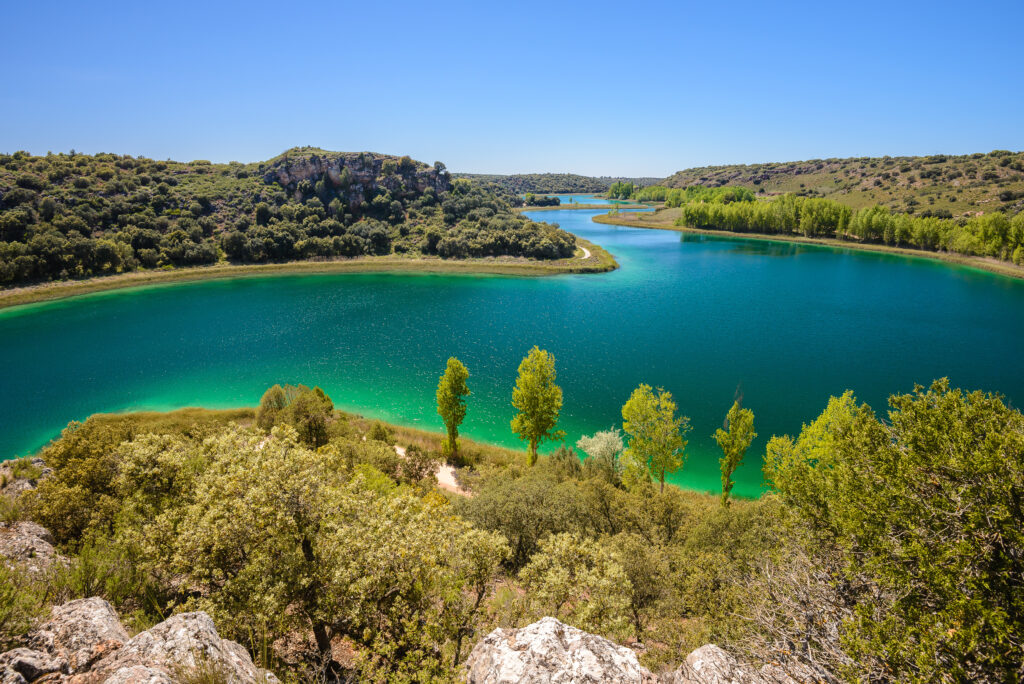
A succession of fifteen lakes in the middle of the steppes of La Mancha form a natural area and a lake district with unique conditions.
The difference in altitude between the first lake – La Blanca – and the last – Laguna del Cenegal – is 120 meters. These two lakes are connected to the ones in between by waterfalls, small streams and underground watercourses. The Lagunas de Ruidera are considered to be the source of the River Guadiana.
They are fed with water by underground watercourses and the River Pinilla. The vegetation consists mainly of reeds, bulrushes and rushes, and near the lakes, there are sade trees and holm oaks. The lakes are home to barbel, pike, carp, water snakes and pond turtles.
Tablas de Daimiel
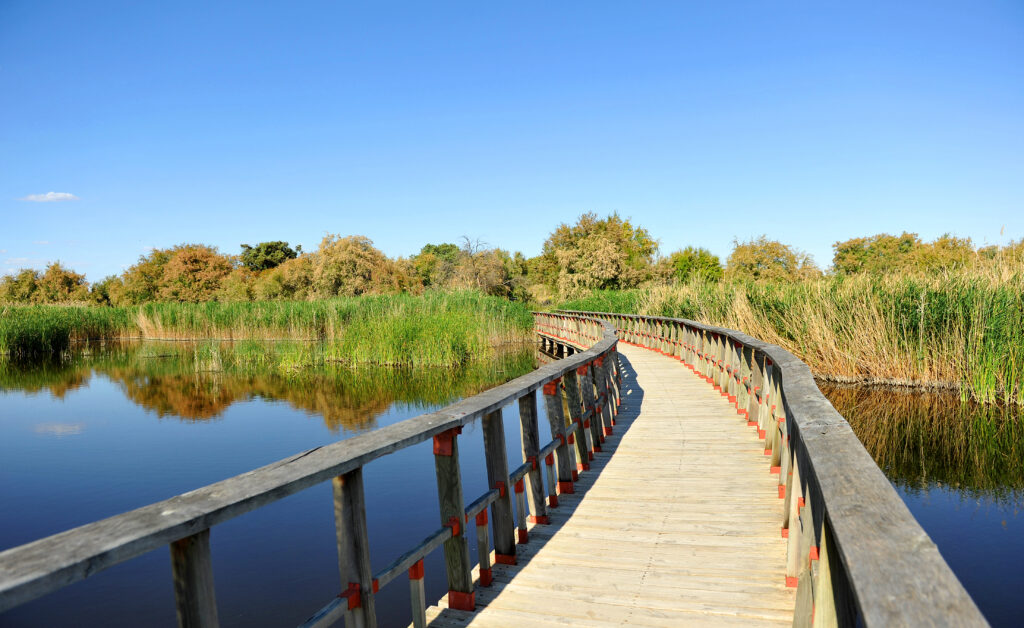
River meadows in the middle of a dusty semi-desert? Yes, there is such a landscape in the south of La Mancha. Reason enough to protect such a natural wonder and designate it as a nature reserve. The Tablas de Daimiel National Park used to be a resting, nesting and wintering area for migratory birds. But all of this is under threat, with climate change and agriculture posing a major threat to the nature park.
The small Tablas de Daimiel National Park to the north-east of the city of Ciudad Real was one of the most important stopovers for wild geese and ducks on their way between their winter and summer quarters. For this reason, it was designated a national park in 1973 and later also a biosphere reserve and protected area in accordance with the European Birds Directive.
The national park’s information center (Centro de Visitantes) is located between the villages of Villarrubia de los Ojos and Daimiel. A circular trail starts from here, some of which crosses wooden bridges over the lagoons of the nature reserve. The hiking trail is flat and 2,500 meters long.
The attraction of the Tablas de Daimiel National Park was the excellent birdwatching opportunities. The past tense “was” is deliberately chosen here. Because the time of large flocks of migratory birds is a thing of the past. And there is little hope of improvement in sight.
Serranía de Cuenca Nature Park
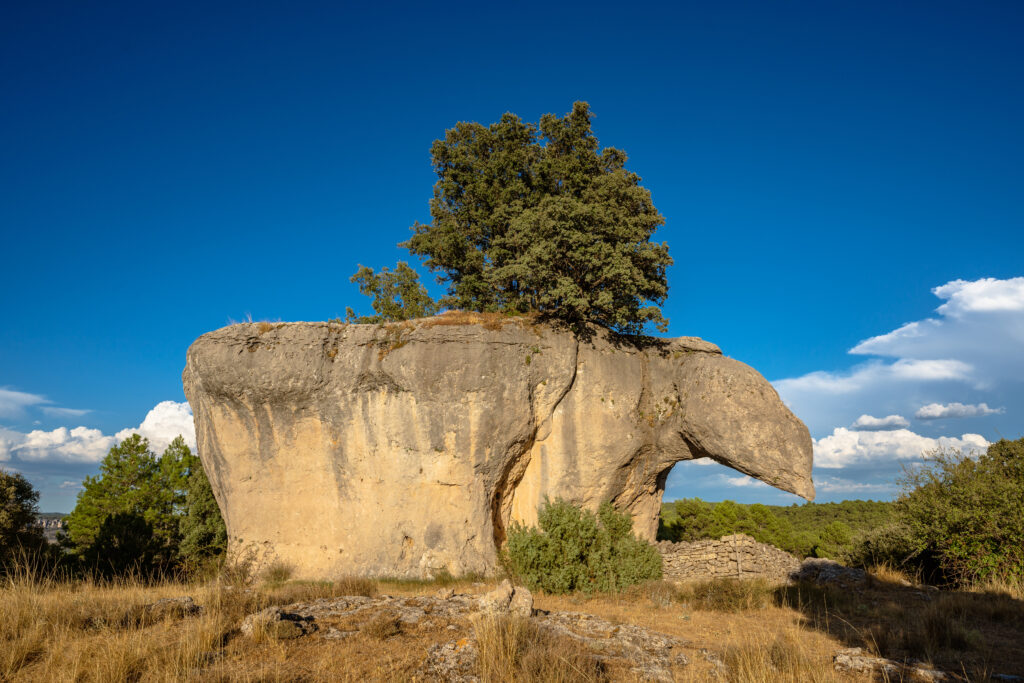
Anyone who has visited the truly enchanting city of Cuenca should not miss the opportunity to head north to the Serranía de Cuenca Nature Park. The Ciudad Encantada is a highlight of this mountain range, which is one of the most densely wooded areas in central Spain.
The reason for the creative power of nature that can be admired here is the specific composition of the limestone. The upper ceiling consists of gray, harder stone. Underneath are layers of rock that turn red and erode more quickly. This is how the special rock formations, whose names speak for themselves, were created over the millennia.
Visitors to the park can indulge in a game: Can they guess the correct names without looking at the existing display boards? But what is correct here? Where the imagination can run wild!
Anyone who wants to can set off on a search: Where are the ships, the dog, a person’s face or where is the theater, the monastery or the Roman bridge? Discover the lovers of Teruel, the elephant fighting with the crocodile, the turtle or the bear?
The circular route through the fenced area is well signposted, so nobody can get lost here. The trail is around 3 kilometers long and can be completed in 90 minutes.
Toledo
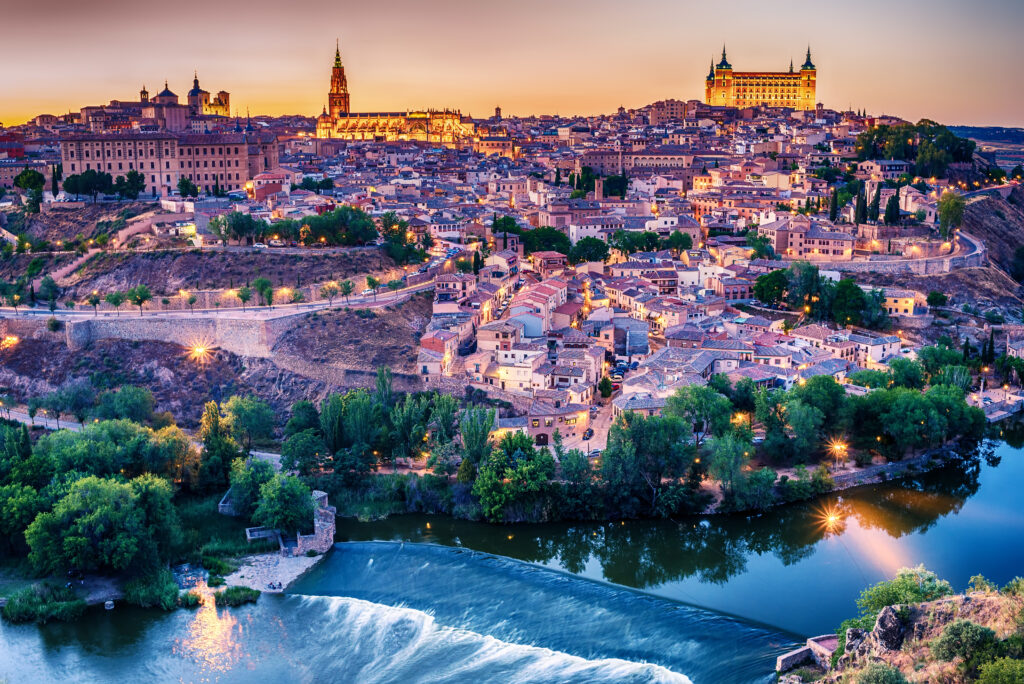
The city of Toledo is one of the most important city break destinations in Spain. The royal palace Alcázar and the cathedral dominate the unique image of the old town of the most important city in the Castilla-La Mancha region in central Spain. Located south of Madrid, the former capital of Spain is also easily accessible by train.
The location is unique. The old town defiantly occupies the 100-metre-high hill, which the river Tagus flows around in a narrow valley. The historic center of Toledo is a UNESCO World Heritage Site.
The layout of the historic center follows the Moorish architecture with winding and confusing alleyways.
The Plaza de Zocodover forms the central main square of the old town. From here, it is not far to the Museo de Santa Cruz history museum, a former hospital in a beautiful Renaissance-style palace. The museum is closely linked to the history of the city of Toledo and exhibits several works by El Greco.
To the south of the main square Zocodover lies the Alcázar on the highest point of the city. Since Roman times, there has been a fortress here in a strategic location, which later also served as a royal residence. The building was badly damaged during the Spanish Civil War. Today it houses the library of the Castilla-La Mancha region and a museum of military history.
The Cathedral of Santa María stands in the center of the city. The church has enormous dimensions: 112 meters long, 56 meters wide and 44 meters high. Despite its different architectural styles, the cathedral is considered one of the most important Gothic churches in Spain due to the long construction period between 1227 and 1493.

